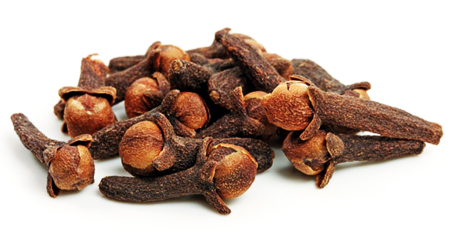What Is Cloves?
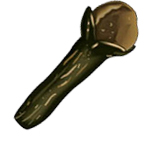
In the culinary arts, cloves are a spice made from the flower buds of an evergreen tree called the clove tree.
Clove flower buds are harvested, unopened, and then dried. Cloves have a very strong, pungent flavor and aroma. They can be used whole or ground. Whole cloves are shaped like a small spike, usually around one centimeter in length, with a bulbous top.
Cloves Plant and Cultivation
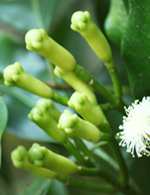
A conical tropical evergreen myrtaceous tree reaching heights of up to 14m (45 ft). The bark is gray, the leaves are a shiny dark green, elliptical in shape and very fragrant. Small crimson flowers grow in triple clusters at the ends of branches. The fruit is a purple drupe, about 2.5 cm (1”) long.
Cloves grow in the tropics and best near the sea. Rainfall must be at least sixty inches per year and a dry season is needed for harvesting and curing. The clove clusters are picked by hand before the buds open and dried on palm mats.
Cloves Description
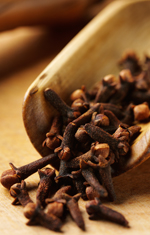
Cloves are the unopened pink flower buds of the evergreen clove tree. The buds are picked by hand when they are pink and dried until they turn brown in color. Cloves are about 1/2-inch long and 1/4-inch in diameter and with their tapered stem, they resemble tiny nails. In fact, their English name is actually derived from the Latin word clavus, which means nail.
Although cloves have a very hard exterior, their flesh features an oily compound that is essential to their nutritional and flavor profile. Cloves have a warm, sweet and aromatic taste that evokes the sultry tropical climates where they are grown.
Uses of Cloves
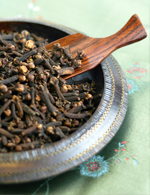
Cloves are used in the cuisine of Asian, African, and the Near and Middle East, lending flavour to meats, curries, and marinades, as well as complement to fruit such as apples, pears, or rhubarb.
In Mexican cuisine, cloves are best known as clavos de olor, and often accompany cumin and cinnamon.
About 85% of cloves' powerful taste is imparted by the chemical eugenol, and the quantity of the spice required is typically relatively small. It pairs well with cinnamon, allspice, vanilla, red wine, and basil, as well as onion, citrus peel, star anise, or peppercorns.
10 Health Benefits of Cloves
1-Toothache – Cloves provide relief from toothache and this is one of the main reasons why you will see them listed as an Ingredient in 99% of toothpastes.
2-Nausea and Vomiting – Cloves and clove oil when taken together can provide relief from Nausea.
3-Cough and Breath – Cough and bad breath can be cured by consuming cloves. These are very common problems that we all face and can be very well treated by the consumption of cloves on a daily basis. You can do this by including them in your dishes and also as refreshments at any time of the day.
4-Seasoning Abilities – Its seasoning capabilities make it very easy to blend in many dishes, beverages and desserts. It helps to provide strong flavour and aroma to the food.
5-Sinusitis – Other benefits include overcoming sinusitis. This can be done by taking the powder of grounded cloves into your nose. This action must be done with a straw of adequate size.
6-Morning sickness – It is a good remedy for treating morning sickness. Take around ten grains of cloves, mix them with tamarind and palm sugar and make it into a nice mixture using water. Drink this solution twice a day as an effective treatment.
7-Flatulence – Clove is mixed with water and used in the preparation of tea to overcome flatulence.
8-Cold – Common cold can be treated effectively by drinking a lukewarm mixture made with ten drops of clove oil and honey. Drink it twice or thrice a day.
9-Aphrodisiac – Clove is also an aphrodisiac and its fragrance eliminates exhaustion and fatigue related thoughts.
10-Stress – It thus soothes the senses and relieves stress in the body. Mix cloves with basil, mint and cardamom in water to make a flavoured tea. Take this along with honey to provide you relief from stress.
Producing Countries of Cloves
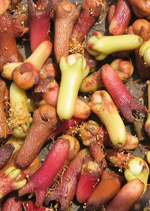
Indonesia is the Largest Producer of Cloves, followed by Madagascar, Zanzibar, India and Srilanka. We have our own office in Madagascar from where we are supplying the best quality of Cloves on the regular basis maintaining the high standards of quality.
Zanzibar is another major producer of cloves contributing approximately 60% to the total world production.
Southern Region in India is known to produce large quantities of Cloves. Karnataka, Kerala and Tamil Nadu are the major cloves producing states.
Consuming Countries of Cloves

Only 30 per cent of all cloves produced are exported. In Indonesia, the world’s largest clove – producing and consuming country, cloves are used to make the Indonesian ‘kretek’, clove –flavouring cigarette. In most other producing countries, the majority of production is exported. The USA is the world’s largest importer and takes most of Brazil’s exports. India is a very large consumer of cloves and sources most of its supply from Sri Lanka.
The major part of the world's consumption of the clove spice is in the home kitchens, the domestic consumption of this spice makes up the largest chunk of the demand for cloves.
Recipe for Beverages with Cloves
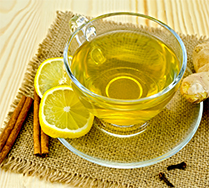
Cloves Tea
IngredientsA: 2 Sups of Water
B: 1 Teaspoon Whole Cloves
C: ½ Teaspoon Grated Nutmeg
D: ½ Teaspoon Ground Cinnamon
E: Few Drops of Lemon Juice
F: Agave nectar or honey (optional)
A: Lightly crush the cloves and put into a saucepan with the nutmeg and cinnamon.
B: Add a cup of water and heat to boiling. Turn the heat down and simmer for 2-3 minutes.
C: Turn off the heat and let steep (sit) for 5 minutes.
D: Pour through a tea strainer and, if using, add the lemon juice or honey or both.
Recipe for Cooking With Cloves
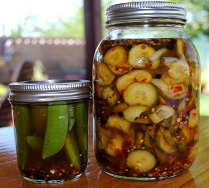
Sweet Spice Pickles
IngredientsA: 3 Pounds Pickling Cucumbers, Sliced ¼” Thick (do not use waxed cucumbers)
B: 1/3 Sup Salt
C: 2 Cups Sugar
D: 3 Cups White Vinegar
E: 2 Teaspoons Whole Cloves
F: 8-10 Cinnamon Sticks
A: Place cucumbers in a container, add salt and top with cold water until covered. Refrigerate for 24 hours before draining liquid (do not rinse).
B: In a large pot, add sugar, vinegar, allspice and cloves and bring to a boil.
C: Fill glass canning jars with the cucumbers and cinnamon sticks, placing at least two sticks in each jar.
D: Pour the hot pickling liquid over the cucumbers, taking care to make sure some cloves and allspice are in each jar.
E: Cover jars and refrigerate for at least 48 hours to complete the pickling process. Pickles will keep in refrigeration for up to one month.
Recipe for Dessert With Cloves
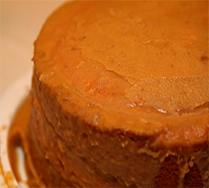
Clove Cake With Caramel Frosting
IngredientsA: Sifted all purpose flour - 3 Cup (48 tbs)
B: Ground cloves - 1 Tablespoon
C: Ground cinnamon - 1 Tablespoon
D: Baking powder - 1 Teaspoon
E: Baking soda - 1⁄2 Teaspoon
F: Salt - 1⁄8 Teaspoon
G: Seedless raisins - 1 Cup (16 tbs)
H: Shortening/Butter/regular margarine - 1 Cup (16 tbs), softened
I: Sugar - 2 1⁄4 Cup (36 tbs)
J: Egg - 5
K: Buttermilk - 1 Cup (16 tbs)
L: Easy caramel frosting - 100 Gram
A: Preheat oven to 350F.
B: Lightly grease 10-by-4- inch tube pan.
C: Sift 2-3/4 cups flour with the cloves, cinnamon, baking powder, soda, and salt; set aside.
D: Toss raisins with remaining flour.
E: In large bowl of electric mixer, at medium speed, beat shortening until creamy.
F: Gradually add sugar, beating until mixture is light and fluffy—about 5 minutes.
G: In small bowl, beat eggs until very light and fluffy. Blend into sugar mixture at medium speed, using rubber scraper to clean side of bowl.
H: At low speed, alternately blend flour mixture (in thirds), and milk (in halves), into sugar-egg mixture, beginning and ending with flour mixture. Beat only until blended. Stir in floured raisins.
I: Pour batter into tube pan; bake 60 to 65 minutes, or until cake tester inserted in the center of the cake comes out clean.
J: Cool in pan on wire rack 20 minutes. Gently loosen with a spatula; turn out of pan onto rack.
K: Cool completely — about 1 hour.
L: Frost with Caramel Frosting.
M: Slice into wedges and serve. Makes 16 servings.

